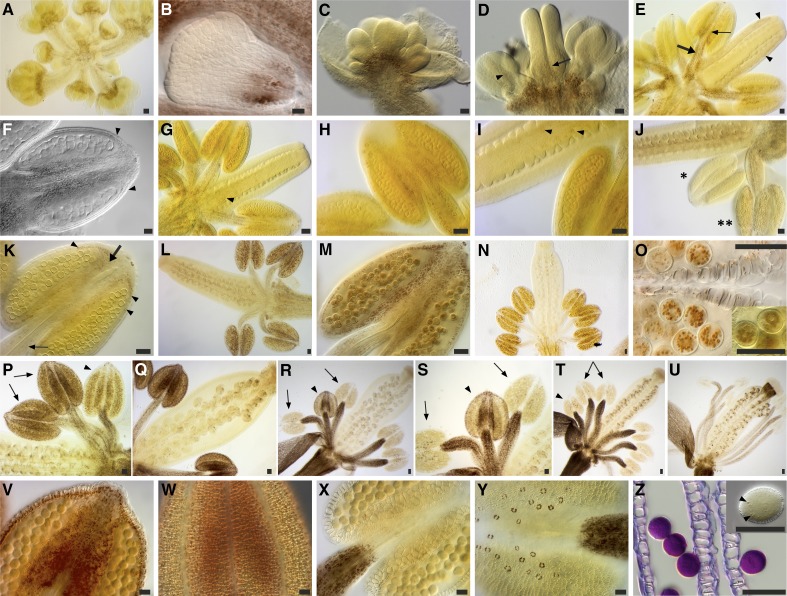Figure 1.
The three starch synthesis waves in the stamen envelope. A to J, First wave. J to O, Second wave. P to Z, Third wave. A, Starch accumulates within the peduncle and the receptacle of young buds. B and C, Closeup images of buds at stages 3 and 7, respectively, where starch accumulates at their basal part and within the peduncle and the receptacle. D, Stage 8 bud where some starch deposits develop within the stamen (arrowhead) and the basal region of the carpel (arrow). E, A flower bud at completion of the development of the four anther wall layers. Starch accumulation extends to the filament (thick arrow) and the connective tissue (thin arrow) and is still seen within the lateral wall of the carpel (arrowheads). F, During male meiosis, starch grain deposits extend to the newly formed endothecium (arrowheads). G to I, Tetrad stage of male meiosis, the first peak of starch amylogenesis in the stamen. In the carpel, starch amylogenesis switched from the lateral wall to the placenta-septum region (arrowheads). J and K, Early microspore development. J, The short stamen (asterisk) just released microspores and is practically devoid of starch grains. The long stamen (double asterisk) have rounded microspores with a much more prominent exine. K, Starch starts to build up again in the filament (thin arrow), the connective tissue (thick arrow), and the staminal envelope (arrowheads). L and M, Bicellular stage (short stamens removed). This stage denotes the peak of the second starch wave in the staminal envelope. Pollen grains show a high starch accumulation. N and O, Late bicellular-early tricellular stage. While most of the starch grains in the staminal envelope are consumed, the pollen grains reach the peak of the unique starch wave. Starch is frequently seen surrounding the vegetative nucleus (inset in O). P to U, Successive developmental stages from the same inflorescence, illustrating the formation of large starch deposits within the sporophytic tissues of the stamen and its subsequent consumption just before anthesis. P, While a short stamen (arrowhead) is still at the end of the second wave, long stamens (arrows) have already started the third amylogenesis wave. Q, All long stamens show high starch deposition and are at the peak of the third starch accumulation wave. R and S, While a short stamen is still at the peak of its third wave, starch deposits already vanished from the anthers of long stamens. T, All stamens are at the same starch deposition stage, maintaining conspicuous starch deposits in the filaments. U, Anthesis. While starch vanishes progressively from the filaments, large deposits appear in the parenchyma of the style. V to Y, Starch accumulation/consumption in the anther during the third starch synthesis wave. V and W, Two optical sections illustrating strong starch accumulation in the endothecium and the connective tissue. X and Y, Two optical sections illustrating how starch disappears from the entire anther except for the stomata; pollen grains continue their amylolytic activity. Z, Mature pollen grains showing an intense Periodic acid-Schiff-positive staining; very few and small starch grains might persist (arrowheads within inset). Flower stages are according to Smyth et al. (1990). Bars = 20 μm.

